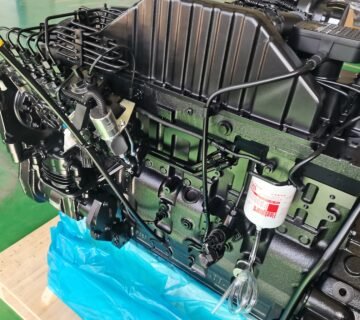How Cummins Engines Achieve High Fuel Efficiency Without Sacrificing Power
In an era where industries demand both performance and sustainability, Cummins Inc. has consistently delivered diesel engines that defy conventional trade-offs. The question arises: How do Cummins engines achieve exceptional fuel efficiency while maintaining robust power output? The answer lies in a combination of cutting-edge engineering, innovative technologies, and decades of expertise. Let’s explore the science behind this balance and why Cummins remains a leader in heavy-duty and medium-duty engine markets.

- Turbocharging Technology: Precision Airflow for Optimal Combustion
At the heart of Cummins’ fuel efficiency strategy is its advanced turbocharging system. Modern Cummins engines utilize Variable Geometry Turbochargers (VGTs), which dynamically adjust airflow based on engine load and RPM. Unlike fixed-geometry turbos, VGTs optimize boost pressure at both low and high speeds, ensuring efficient combustion without lag. This translates to low RPM torque optimization—delivering power when needed while minimizing fuel waste during idle or light-load conditions.
For instance, the Cummins X15 engine employs an aerodynamic turbo design that reduces backpressure, allowing exhaust gases to flow freely. This not only enhances horsepower but also lowers fuel consumption by up to 6% compared to older models.
- Advanced Fuel Injection Systems: Precision Meets Power
Cummins’XPI (Extra-High Pressure Injection)system is a game-changer. By injecting fuel at pressures exceeding 35,000 psi, the engine achieves a finer spray pattern, resulting in a more complete burn. This precision-engineered combustion processmaximizes energy extraction from each drop of diesel, reducing unburned fuel emissions and improving mileage.
Moreover, Cummins’adaptive exhaust flow management ensures that fuel injection timing adjusts in real-time based on operating conditions. Whether hauling heavy loads or cruising on highways, the engine maintains an optimal air-fuel ratio, balancing performance and economy.
- Intelligent Engine Management: The Role of AI and Data
Cummins’ADEPT™ (Advanced Dynamic Efficient Powertrain Technology)integrates smart software with hardware to predict and adapt to driving patterns. Using sensors and predictive algorithms, the system automatically adjusts gear shifting, throttle response, and braking to reduce unnecessary fuel use. For fleet operators, this means predictive engine calibration can lower operating costs by up to 10%.
Additionally, Cummins’ Connected Diagnostics platform leverages IoT to monitor engine health in real-time. By identifying inefficiencies—such as clogged filters or misaligned injectors—before they escalate, operators can avoid costly downtime and maintain peak fuel efficiency.
- Emission Control Without Compromise
Meeting stringent global standards like EPA Tier 4 Final and Euro VI, Cummins engines incorporate exhaust gas recirculation (EGR) andSelective Catalytic Reduction (SCR) systems. While EGR lowers combustion temperatures to reduce NOx emissions, SCR uses Diesel Exhaust Fluid (DEF) to break down pollutants. Crucially, these technologies are designed to work synergistically, ensuring compliance without sacrificing horsepower or torque.
For example, the Cummins B6.7 engine pairs a compact aftertreatment system with a high-efficiency SCR, achieving a 90% reduction in NOx emissions while maintaining the durable engine componentsneeded for heavy-duty applications.
- Lightweight Materials and Aerodynamic Design
Cummins engineers have mastered the art of weight reduction without compromising durability. The Cummins X12 engine, for instance, uses compacted graphite iron (CGI) in its block, shedding nearly 500 pounds compared to traditional designs. Lighter engines mean vehicles expend less energy accelerating, directly improving fuel economy.

Furthermore, advancements in thermal efficiency—such as improved cylinder head cooling and reduced friction bearings—ensure that more energy from fuel is converted into usable power rather than wasted as heat.
Real-World Applications: Where Efficiency Meets Performance
From long-haul trucks to construction equipment, Cummins engines prove their versatility:
– Over-the-Road Trucking: The Cummins ISX15 achieves up to 8% better fuel economy than previous models, thanks to its aerodynamic turbo design and optimized gear ratios.
– Construction Sites: The QSK60 engine powers cranes and excavators with high torque at low RPMs, reducing fuel burn during repetitive lifting tasks.
– Emergency Generators: Cummins’quiet, fuel-efficient diesel engines ensure hospitals and data centers stay operational during outages, with minimal refueling needs.
Conclusion: The Cummins Advantage
Cummins engines exemplify the harmony between innovation and practicality. By integrating variable geometry turbochargers,precision fuel injection, and AI-driven management systems, they deliver fuel-efficient diesel engines that don’t compromise on power. Whether navigating steep inclines or idling in traffic, Cummins’ commitment to low RPM torque optimization and adaptive exhaust flow management ensures operators save fuel without sacrificing performance.
For industries seeking to reduce costs and environmental impact, Cummins offers a proven solution: engines designed to work smarter, not harder. Explore Cummins’ lineup today and discover how heavy-duty performance and sustainability can coexist.





No comment